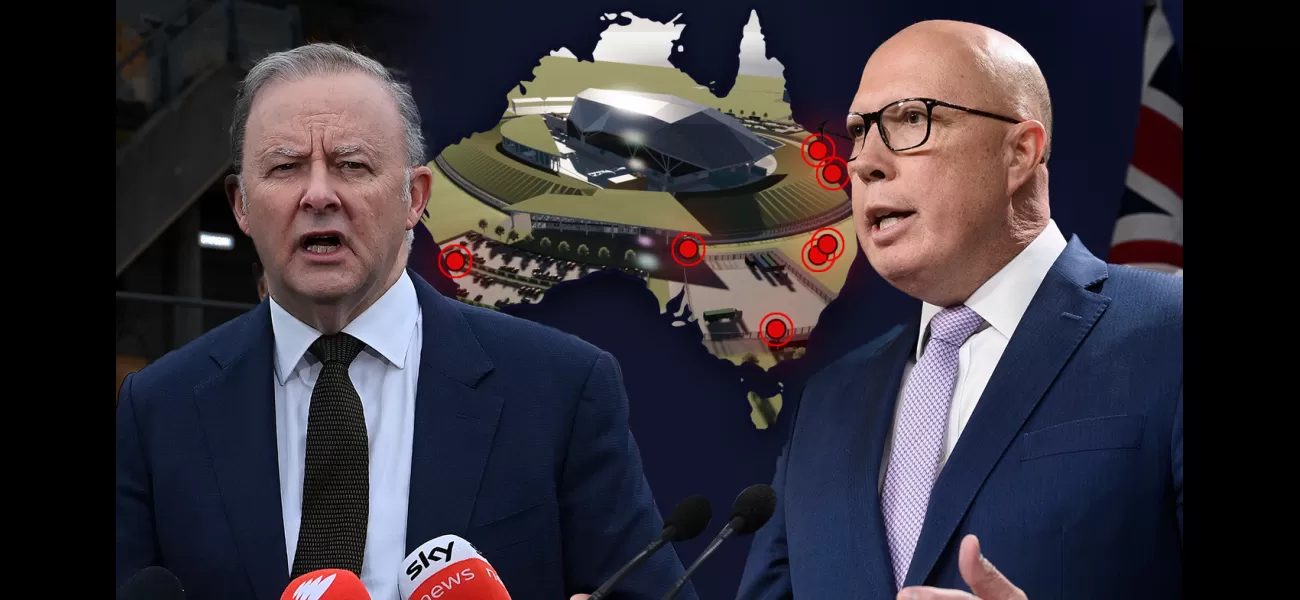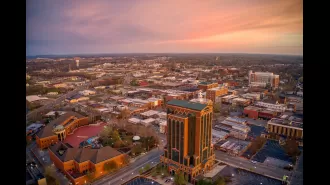Upcoming vote on energy after nuclear news.
Upcoming proposal could shape election and greatly affect Australia's energy supply and electricity costs.
June 19th 2024.

As the next election draws near, the federal government and opposition are gearing up for a potential referendum on energy. This comes after the Coalition recently revealed some aspects of their highly anticipated nuclear power plan. While this proposal could be a defining factor in the upcoming election, it also has the potential to greatly impact Australia's energy supply, specific local communities, and even your power bills. Here's what you need to know about the opposition's nuclear plan.
One of the main concerns surrounding the plan is the cost of building and maintaining nuclear power plants. However, Opposition Leader Peter Dutton has been vague about the exact amount taxpayers will have to fork out for these facilities, only acknowledging that it will be a substantial sum. He has yet to disclose when the cost will be announced or if it will be revealed before the election.
Experts in the energy field have consistently stated that nuclear-generated power would be significantly more expensive than renewable sources such as solar and wind. Associate Professor Roger Dargaville from Monash University's Energy Institute explains that "[nuclear] has been clearly shown to be more expensive than renewables plus storage." This means that choosing nuclear power could result in higher energy prices for consumers. Additionally, nuclear energy would not be able to immediately lower energy prices, as it takes around 15 years to set up a nuclear power plant. This could lead to a shortage in power production during the transition period.
The opposition, however, argues that nuclear energy will ultimately reduce power prices. They plan to replace seven coal-fired power plants with nuclear reactors, including Liddell Power Station in Muswellbrook, NSW, and Muja Power Station in Collie, WA. By utilizing existing energy sites, they believe they can save money by utilizing existing infrastructure to connect nuclear power to the grid.
Another crucial aspect of the plan is the management of nuclear waste. Dutton has stated that the waste from the power plants will be stored on-site until the stations shut down. After that, the Coalition intends to store the waste alongside the waste from Australia's future nuclear-powered AUKUS submarines, although the location for this storage is yet to be determined. This is a significant issue that needs to be addressed before nuclear power can be implemented, according to experts. Dr. Nathan Garland from Griffith University explains that "we currently have no long-term storage policy and method to do so, and this has to be talked about first before any nuclear site is proposed."
One contentious issue surrounding the plan is the timeline for when the nuclear power plants will come online. The Coalition claims they can have the first two reactors operational by 2035 if small modular reactors are feasible, or by 2037 if conventional nuclear stations are required. However, energy experts believe this timeline is overly optimistic, with Emeritus Professor Ken Baldwin from ANU stating that "we're talking about timeframes of 15 years...to actually see something operating on the ground." The CSIRO has also estimated that at least 15 years would be needed to develop nuclear power in Australia. Dutton has stated that all seven reactors will be online sometime in the 2040s.
One of the roadblocks in this timeline is the lack of a skilled nuclear workforce in Australia. Dr. Garland points out that the current workforce is "miniscule" and would require significant time and costs to be properly developed. This is another crucial factor that needs to be addressed before nuclear power can become a reality in Australia.
In conclusion, the opposition's nuclear plan is a complex and highly debated issue that could have significant consequences for Australia's energy future. While it could potentially bring down power prices in the long run, there are several roadblocks that need to be overcome before it can become a reality. The cost, waste management, and timeline are all crucial factors that need to be thoroughly addressed before any nuclear power plants can be built in Australia.
As the next election draws near, both the federal government and opposition are preparing for a referendum on energy after the Coalition revealed some details of their long-awaited nuclear power plan. This proposal has the potential to be the defining issue of the upcoming election and could have a significant impact on Australia's energy supply, local communities, and even your power bills.
So, what does the opposition's nuclear plan entail? Well, for starters, we don't know how much it will cost. While Opposition Leader Peter Dutton has stated that the power stations will be publicly owned, he has yet to disclose the exact amount taxpayers will be footing the bill for. He did mention that it will be a "big bill," but has not given a timeline for when this information will be made public or if it will be revealed before the election.
One concern that has been raised by energy experts is the potential increase in energy bills if nuclear power is implemented. The CSIRO and others have consistently stated that nuclear-generated energy would be much more expensive compared to renewable sources like solar and wind. Associate Professor Roger Dargaville from Monash University's Energy Institute explains that "nuclear has been clearly shown to be more expensive than renewables plus storage," and choosing this path would ultimately result in higher energy prices for consumers.
Furthermore, nuclear power would not have an immediate impact on lowering energy prices. It takes a considerable amount of time to set up nuclear reactors, meaning it could be at least 15 years before we see any decrease in energy costs. This delay could potentially lead to a shortfall in power production as aging coal-fired plants are phased out.
Despite these concerns, the opposition insists that nuclear energy will bring down power prices. Their plan involves replacing seven coal-fired power plants with nuclear reactors once they shut down. These plants include Liddell Power Station in Muswellbrook, Mount Piper Power Station in Lithgow, Loy Yang Power Stations in the La Trobe Valley, Tarong Power Station in Queensland, Callide Power Station in Mount Murchison, Northern Power Station in South Australia, and Muja Power Station in Western Australia.
By building the reactors at existing energy sites, the opposition claims that they can save money by utilizing the existing infrastructure to connect nuclear power to the grid. However, one major concern that has been raised is the issue of nuclear waste. Dutton has stated that the waste from the power plants will be stored on-site until the stations shut down. After that, the plan is to store the waste at the same location as the waste from Australia's future nuclear-powered AUKUS submarines, though the exact location has yet to be determined. This is a critical issue that needs to be addressed before nuclear power can move forward, according to experts.
One of the most debated aspects of the opposition's policy is the timeline for when the nuclear power plants will come online. They claim that the first two reactors can be operational by 2035 if small modular reactors are feasible, or by 2037 if conventional nuclear stations are required. However, energy experts believe that these timelines are unrealistic, with Emeritus Professor Ken Baldwin from ANU stating that it could take at least 15 years for nuclear power to be developed in Australia. Dutton has stated that all seven reactors will be online sometime in the 2040s.
One of the main roadblocks to this timeline is Australia's nuclear workforce, which is currently quite small. Dr. Nathan Garland from Griffith University explains that it would take a considerable amount of time and resources to properly build up this workforce. This is something that needs to be taken into consideration before any nuclear sites are proposed.
In conclusion, while the opposition's nuclear plan may seem promising, there are still many unanswered questions and concerns that need to be addressed before moving forward. The cost, potential impact on energy prices, and the issue of nuclear waste all need to be carefully considered, along with the timeline and workforce needed to make this plan a reality. As always, a thorough and mature debate is necessary before any major decisions are made.
One of the main concerns surrounding the plan is the cost of building and maintaining nuclear power plants. However, Opposition Leader Peter Dutton has been vague about the exact amount taxpayers will have to fork out for these facilities, only acknowledging that it will be a substantial sum. He has yet to disclose when the cost will be announced or if it will be revealed before the election.
Experts in the energy field have consistently stated that nuclear-generated power would be significantly more expensive than renewable sources such as solar and wind. Associate Professor Roger Dargaville from Monash University's Energy Institute explains that "[nuclear] has been clearly shown to be more expensive than renewables plus storage." This means that choosing nuclear power could result in higher energy prices for consumers. Additionally, nuclear energy would not be able to immediately lower energy prices, as it takes around 15 years to set up a nuclear power plant. This could lead to a shortage in power production during the transition period.
The opposition, however, argues that nuclear energy will ultimately reduce power prices. They plan to replace seven coal-fired power plants with nuclear reactors, including Liddell Power Station in Muswellbrook, NSW, and Muja Power Station in Collie, WA. By utilizing existing energy sites, they believe they can save money by utilizing existing infrastructure to connect nuclear power to the grid.
Another crucial aspect of the plan is the management of nuclear waste. Dutton has stated that the waste from the power plants will be stored on-site until the stations shut down. After that, the Coalition intends to store the waste alongside the waste from Australia's future nuclear-powered AUKUS submarines, although the location for this storage is yet to be determined. This is a significant issue that needs to be addressed before nuclear power can be implemented, according to experts. Dr. Nathan Garland from Griffith University explains that "we currently have no long-term storage policy and method to do so, and this has to be talked about first before any nuclear site is proposed."
One contentious issue surrounding the plan is the timeline for when the nuclear power plants will come online. The Coalition claims they can have the first two reactors operational by 2035 if small modular reactors are feasible, or by 2037 if conventional nuclear stations are required. However, energy experts believe this timeline is overly optimistic, with Emeritus Professor Ken Baldwin from ANU stating that "we're talking about timeframes of 15 years...to actually see something operating on the ground." The CSIRO has also estimated that at least 15 years would be needed to develop nuclear power in Australia. Dutton has stated that all seven reactors will be online sometime in the 2040s.
One of the roadblocks in this timeline is the lack of a skilled nuclear workforce in Australia. Dr. Garland points out that the current workforce is "miniscule" and would require significant time and costs to be properly developed. This is another crucial factor that needs to be addressed before nuclear power can become a reality in Australia.
In conclusion, the opposition's nuclear plan is a complex and highly debated issue that could have significant consequences for Australia's energy future. While it could potentially bring down power prices in the long run, there are several roadblocks that need to be overcome before it can become a reality. The cost, waste management, and timeline are all crucial factors that need to be thoroughly addressed before any nuclear power plants can be built in Australia.
As the next election draws near, both the federal government and opposition are preparing for a referendum on energy after the Coalition revealed some details of their long-awaited nuclear power plan. This proposal has the potential to be the defining issue of the upcoming election and could have a significant impact on Australia's energy supply, local communities, and even your power bills.
So, what does the opposition's nuclear plan entail? Well, for starters, we don't know how much it will cost. While Opposition Leader Peter Dutton has stated that the power stations will be publicly owned, he has yet to disclose the exact amount taxpayers will be footing the bill for. He did mention that it will be a "big bill," but has not given a timeline for when this information will be made public or if it will be revealed before the election.
One concern that has been raised by energy experts is the potential increase in energy bills if nuclear power is implemented. The CSIRO and others have consistently stated that nuclear-generated energy would be much more expensive compared to renewable sources like solar and wind. Associate Professor Roger Dargaville from Monash University's Energy Institute explains that "nuclear has been clearly shown to be more expensive than renewables plus storage," and choosing this path would ultimately result in higher energy prices for consumers.
Furthermore, nuclear power would not have an immediate impact on lowering energy prices. It takes a considerable amount of time to set up nuclear reactors, meaning it could be at least 15 years before we see any decrease in energy costs. This delay could potentially lead to a shortfall in power production as aging coal-fired plants are phased out.
Despite these concerns, the opposition insists that nuclear energy will bring down power prices. Their plan involves replacing seven coal-fired power plants with nuclear reactors once they shut down. These plants include Liddell Power Station in Muswellbrook, Mount Piper Power Station in Lithgow, Loy Yang Power Stations in the La Trobe Valley, Tarong Power Station in Queensland, Callide Power Station in Mount Murchison, Northern Power Station in South Australia, and Muja Power Station in Western Australia.
By building the reactors at existing energy sites, the opposition claims that they can save money by utilizing the existing infrastructure to connect nuclear power to the grid. However, one major concern that has been raised is the issue of nuclear waste. Dutton has stated that the waste from the power plants will be stored on-site until the stations shut down. After that, the plan is to store the waste at the same location as the waste from Australia's future nuclear-powered AUKUS submarines, though the exact location has yet to be determined. This is a critical issue that needs to be addressed before nuclear power can move forward, according to experts.
One of the most debated aspects of the opposition's policy is the timeline for when the nuclear power plants will come online. They claim that the first two reactors can be operational by 2035 if small modular reactors are feasible, or by 2037 if conventional nuclear stations are required. However, energy experts believe that these timelines are unrealistic, with Emeritus Professor Ken Baldwin from ANU stating that it could take at least 15 years for nuclear power to be developed in Australia. Dutton has stated that all seven reactors will be online sometime in the 2040s.
One of the main roadblocks to this timeline is Australia's nuclear workforce, which is currently quite small. Dr. Nathan Garland from Griffith University explains that it would take a considerable amount of time and resources to properly build up this workforce. This is something that needs to be taken into consideration before any nuclear sites are proposed.
In conclusion, while the opposition's nuclear plan may seem promising, there are still many unanswered questions and concerns that need to be addressed before moving forward. The cost, potential impact on energy prices, and the issue of nuclear waste all need to be carefully considered, along with the timeline and workforce needed to make this plan a reality. As always, a thorough and mature debate is necessary before any major decisions are made.
[This article has been trending online recently and has been generated with AI. Your feed is customized.]
[Generative AI is experimental.]
0
0
Submit Comment





